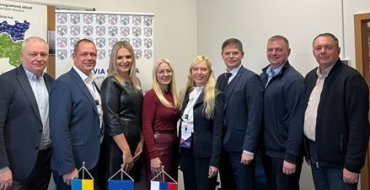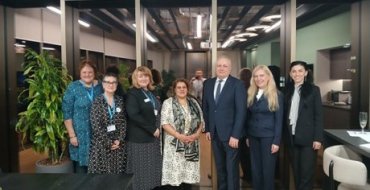“The Holocaust Transformed the Postwar World and the Memory of War”: An International Project Dedicated to the Holocaust Launched at Uzhhorod University
As part of The Claims Conference University Partnership Program in Holocaust Studies, Uzhhorod National University is launching courses on the history of the Holocaust. During two semesters of the 2025–2026 academic year, bachelor’s, master’s, and PhD students will be able to attend lectures by Pavlo Khudish, PhD in History, Associate Professor at the Department of Archaeology, Ethnology, and Cultural Studies of the Faculty of History and International Relations at UzhNU. Uzhhorod National University has become the third higher education institution in Ukraine to be granted the right to participate in this program.
According to the lecturer, throughout the course students will be able to study the history of the Holocaust in depth as one of the most horrific crimes in human history. The courses are designed to explain the Holocaust, its background, and consequences through the perspective of direct participants – the survivors who left their testimonies, memories, and memoirs.
“We will learn how Jews coexisted and interacted with other peoples before World War II, what changed with the rise to power of the Nazis, their allies, and collaborators, and how the Holocaust transformed the postwar world and the memory of the war,” says Pavlo Khudish, the author and lecturer of the course. “I am convinced that so-called ‘dry historical facts’ explain very little, which is why together with students we will delve into the analysis of diverse life experiences of ordinary people—both Jews and non-Jews—who lived through extreme violence during World War II. Sometimes these people fought against or cooperated with evil, sometimes they survived on their own or helped others to survive, sometimes they stood aside or became victims themselves, but most often their experience was complex, multifaceted, and dynamic. Understanding this complex dynamic of mass violence during World War II gives us a key to analyzing other crimes, including those committed by the Russian army on the territory of Ukraine since 2014.”
During the semester, students will be able to choose from three elective courses:
- Introduction to the History of the Holocaust
- The German-Soviet War and the “Holocaust by Bullets” on the Territory of Ukraine
- The History of the Jewish Community and the Holocaust in Transcarpathia
According to Khudish, the most popular among students turned out to be the course on the Holocaust in Transcarpathia: more than 20 students registered for it. He adds that the courses will follow the flipped classroom methodology.

“Before each lecture, students will receive several sources (memoirs, diaries, or video interviews of Holocaust survivors), as well as selected short paragraphs from academic literature,” says Khudish. “During class we will, using detailed source-based questionnaires, analyze, debate, and discuss together. Students should learn to think critically, ask profound questions of sources, verify them, and understand their complexity.”
The author and lecturer, Pavlo Khudish, has been researching the Holocaust for over 10 years. In 2016, he defended his dissertation on postwar Transcarpathia through the prism of Czechoslovak–Soviet relations. His research focused on the process of the region’s incorporation into the USSR, the diplomatic complications around it, Czechoslovakia’s attempt to restore its pre-Munich borders, and the migration processes that followed and resulted from the change of state affiliation. This included the “optation” of Czechs and Slovaks, which was supposed to be a voluntary choice of citizenship in favor of Czechoslovakia, but in reality was far from voluntary.

“Thousands of Holocaust survivors who returned to Transcarpathia in late 1944 and especially in 1945 also took part in this process. Out of more than 100,000 Jewish men, women, and children, only 15,000–17,000 survived the Shoah and returned. Soon afterward, most of them left the region at the time when the USSR was gradually lowering the ‘Iron Curtain,’” Khudish explains. “I became deeply interested in the relationships Holocaust survivors had with their non-Jewish neighbors, with state authorities at different levels, and with other historical actors. What happened to Jewish property, and were they able to reclaim it? If not, why? And ultimately, what motivated survivors to leave or to stay? It was these questions and many related ones that I began to explore in greater depth after my defense, developing one of the chapters of my dissertation. In short, the research continues.”
According to Khudish, the history of the Holocaust is an integral part of the history of Ukraine, and while Jews were the main target of the Nazis, their allies, and collaborators, their fates were closely intertwined with those of other victim groups.
“These include people with disabilities, Soviet prisoners of war, and other vulnerable groups, among whom were many Ukrainians. Among them were also Roma, who had long lived in Ukrainian lands and became targets of extermination during the Holocaust,” he notes.

He adds that it is important not only to remember that Ukraine ranks fourth in the world in the number of the Righteous Among the Nations - people who selflessly saved Jews during the war - but also to have a mature conversation about the participation of some Ukrainians and organizations in the Holocaust on the side of the perpetrators.
“The Shoah – a Hebrew term for the Holocaust meaning ‘catastrophe’ – was a multifaceted process that unfolded step by step during World War II and revealed an extraordinarily wide and dynamic spectrum of behavioral responses. It is precisely this complexity that I will try to explain to my students, teaching them to ask questions: of sources, of texts, and of themselves,” says Pavlo Khudish.
Anastasiya Lendel,
Information and Publishing Center of UzhNU















